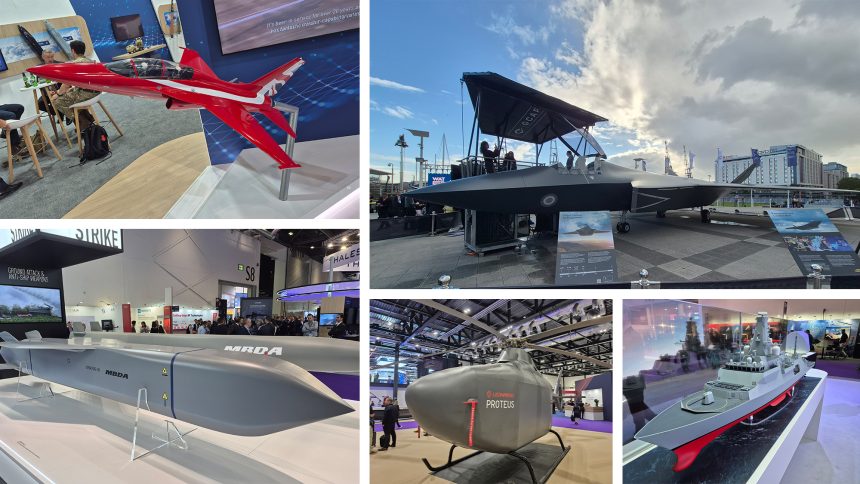As this year’s Defence and Security Equipment International (DSEI) exhibition prepares for its final day at ExCel London, let’s cast our eyes over some of the stories that have emerged so far from the major industry event.
DSEI, held in London every two years, is always a highlight for news relating to defence and security. DSEI 2023 saw the official launch of the multinational Global Combat Air Programme (GCAP), as the exhibition responded to the Russian invasion of Ukraine with an increased focus on counter unmanned aerial systems (C-UAS) technology and building up Europe’s military forces with advanced, but highly scaleable, new designs.
2025’s edition, coming three years after Russia’s invasion, and following massive geopolitical shifts resulting from rapidly evolving events across the Middle East, has been more hotly anticipated (and protested) than ever. The Aviationist contributor James Gray, who attended DSEI on Sept. 11, noted that GCAP and developments around FC/ASW, now named STRATUS, appeared to be key focuses this year among those attending, but that one way effectors were the ‘theme’ of the event.
Edgewing Debut
Making its first DSEI appearance under the Edgewing banner – the name of the international organisation that will oversee its development – there have been a number of announcements relating to the UK-Japan-Italy GCAP fighter. A mockup of the aircraft was shown off to arriving guests as a ‘gate guard’, drawing notable interest from Hiroshi Suzuki, the much celebrated Japanese Ambassador to the United Kingdom.
Impressive full-scale model of 🇯🇵🇬🇧🇮🇹 GCAP fighter jet!! On display at DSEI UK 2025 at #Excel London. Don’t miss it, on till 12 Sep! pic.twitter.com/GzUmjcWt5V
— Hiroshi Suzuki (@AmbJapanUK) September 10, 2025
Closer inspection of the model by defence journalists revealed an interesting nod to a potential feature for the aircraft which has yet to be announced or confirmed. Looking at the rear of the aircraft, the exhausts appear to be shaped in a way which could suggest the integration of F-22 Raptor-style 2D thrust vectoring. Alternatively, it is also possible that the shape is simply part of the airframes’ radar and infrared signature reduction measures.
Morning from Day 3 of #DSEI ! (Nb GCAP mock-up showing off 2D thrust-vectoring nozzles here?) #avgeek pic.twitter.com/FeNMbPCftO
— Tim Robinson (@RAeSTimR) September 11, 2025
Thrust vectoring was intended to be incorporated on Japan’s Mitsubishi F-X future fighter, which was eventually merged into GCAP. The technology was seen used on the X-2 testbed flown in 2016. Upgrades to the Eurofighter Typhoon that included thrust vectoring were also previously proposed, but this development has never been fully funded. Among pilots, views on thrust vectoring vary widely. The thrust vectoring capabilities of aircraft like the F-22 Raptor and Sukhoi Su-30 are huge crowd-pleasers at airshows, and undoubtedly offer an extraordinary capability to outmaneuver an opponent in a close quarters dogfight.
However, detractors point out that the use of thrust vectoring can lead to an excessive bleed of kinetic energy, meaning that if a pilot is unable to effect a ‘kill’ after performing a thrust vectoring-enabled maneuver they may subsequently be left as a sitting duck for a counter attack by guns or missiles. Its utility primarily in close quarters combat is also criticized with modern air to air engagements more frequently undertaken at longer ranges.
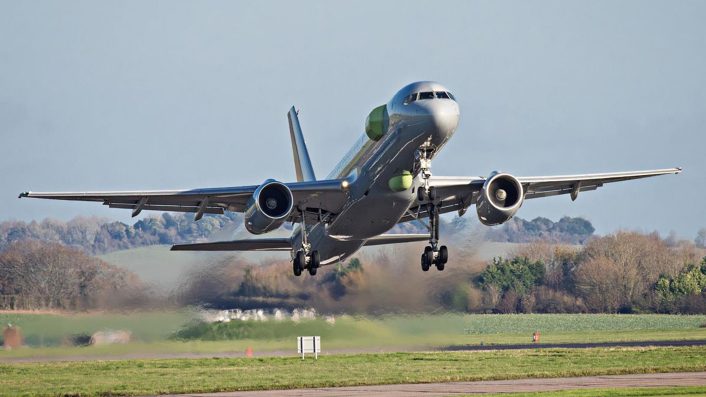
Also announced was an expansion in the use of airborne testbeds for GCAP development. The UK has already commissioned a Boeing 757 based testbed airframe, named Excalibur, which has been active from MoD Boscombe Down. Augmenting Excalibur, it appears that Italy will field a testbed based on a Gulfstream business jet, while Japan will modify a Kawasaki C-2 transport aircraft.
GCAP will now likely support 3 flight test airborne labs for radar/sensors/comms – 757 Excalibur in UK, Gulfstream bizjet in Italy, and modified C2 transport in Japan. https://t.co/2uxJVHC32G
— Tim Robinson (@RAeSTimR) September 9, 2025
FC/ASW Becomes STRATUS
Some more clarity regarding the MBDA Future Cruise/Anti-Ship Weapon, or FC/ASW, was revealed on Sept. 10 when the programme was formally given the name STRATUS. STRATUS will comprise two types of missile – STRATUS LO (Low Observable), formerly known as TP15, will be a subsonic, stealthy cruise missile designed to replace MBDA’s Storm Shadow/SCALP-EG, while STRATUS RS (Rapid Strike), formerly RJ10, will be an advanced ramjet-powered, high-maneuverability supersonic (Mach 3-5) missile. France leads development on STRATUS RS, while the UK leads on STRATUS LO.

Mockups displayed of both missile types show roughly similar proportions. If this carries over to the final designs, both missiles may be able to be launched by an equally wide selection of platforms. As well as traditional air-launch from fighter aircraft and vertical launch from ships, there is also future potential for ground launch. The missiles will have a high degree of commonality.
Italy is reportedly making approaches towards joining the UK-France team, expressing interest in both missile types.
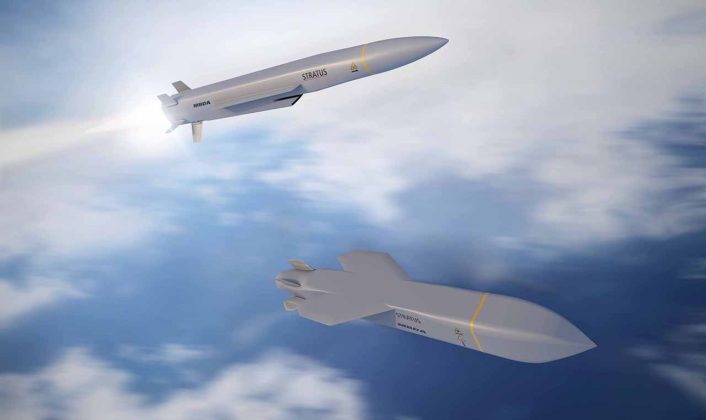
Red Arrows KAI T-50
As one of the rumored contenders for the UK’s next jet trainer, a scale model of the Korea Aerospace Industries T-50 was shown off in a livery clearly based on that of the Royal Air Force’s Red Arrows display team. While the RAF seeks to replace the Hawk T2 as its advanced jet trainer, it is the replacement of the venerable Hawk T1s used by the display team that has arguably generated the most discussion in UK mainstream media.
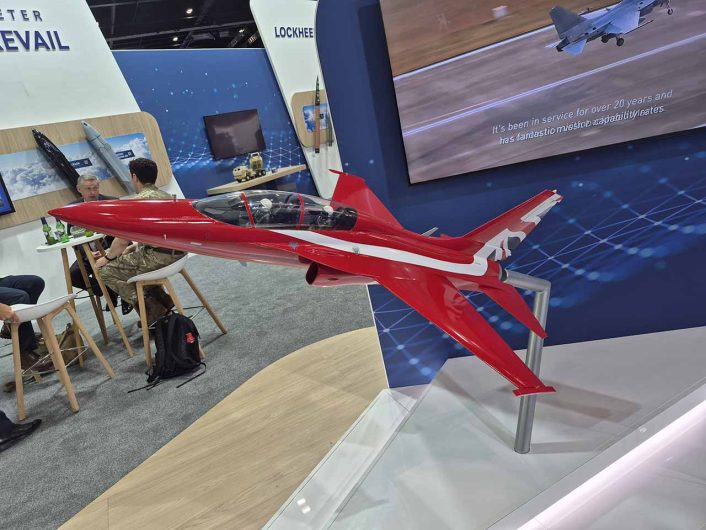
The T-50 faces tough competition here, with homegrown Aeralis also making its presence known at DSEI with its innovative configurable airframe concept. Though Aeralis is a new kid on the block, having yet to produce a flying airframe, its British roots will help its case in terms of promoting UK industry – a key driver behind the Red Arrows. Other contenders include Leonardo’s M-345 and M-346 aircraft, the Boeing-Saab T-7 Red Hawk, and the Turkish Hürjet.
One fuselage, multiple variants – Aeralis showing off its modular light jet concept here at #DSEI2025 #DSEI pic.twitter.com/TeFsIbBcg1
— Tim Robinson (@RAeSTimR) September 10, 2025
Jet-powered CCAs on Queen Elizabeth class by 2026?
First Sea Lord General Sir Gwyn Jenkins, speaking at DSEI 2025 as the first ever Royal Marine to lead the Royal Navy, delivered a major speech on Sept. 9 outlining his intent to rapidly reshape and strengthen the Royal Navy. One element of this will be the fielding of hybrid manned-unmanned air wings on the Queen Elizabeth class aircraft carriers, which was recommended in the 2025 Strategic Defence Review.
Jenkins claimed that by the end of next year (2026), a jet-powered unmanned collaborative combat aircraft (CCA) concept will be launched from one of the Royal Navy’s two carriers. This will most likely be HMS Queen Elizabeth, which is currently dry-docked in Scotland for a general refit and hull re-certification. The General says that by the time of the Royal Navy’s next Indo-Pacific carrier deployment, the carrier air wing will be “almost unrecognisable”.
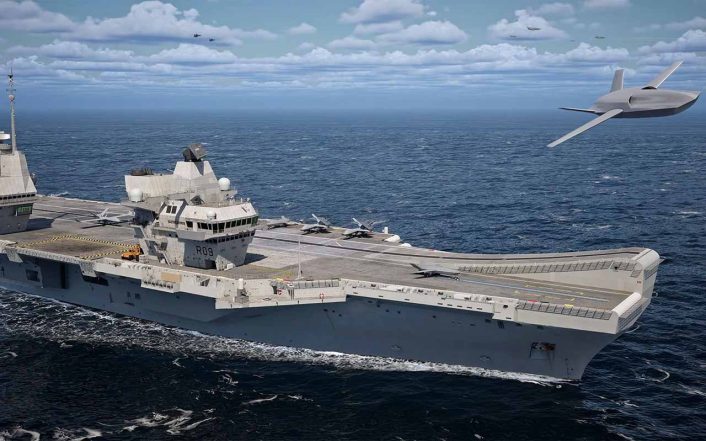
Though still centered around the F-35B, with Merlin helicopters for anti-submarine warfare (ASW), the air wing will be augmented by an array of unmanned aircraft – both fixed wing and rotary wing – that will extend sensor ranges, add additional weapons capabilities, and provide persistent intelligence, surveillance, and reconnaissance (ISR) around the carrier strike group. Limited examples of this can be seen on the current CSG 25 deployment, where HMS Prince of Wales has deployed with a number of Malloy T-150 drones for cargo transfer, and Puma drones for ISR.
Atlantic Bastion
Uncrewed surface vessels (USVs) and remote sensors will team up with new frigates to create a new ‘Atlantic Bastion’, protecting the Atlantic from hostile undersea warfare. The first sensors, Jenkins says, will be deployed next year. Within the next two years, Royal Navy USVs will be in the water, ready to act as uncrewed escorts for manned Type 26 anti-submarine frigates. One Type 26 would go to sea patrolling the Atlantic Bastion with two of these escorts, and they are also expected to join the next Indo-Pacific carrier strike group deployment.
ASW will hinge around the Bastion Atlantic concept, which includes uncrewed types, the Type 92 sloop – essentially a LUSV VDS tug – and the Type 93 chariot – an XLUUV. These together with wave gliders will deliver persistent subsurface surveillance accross the GIUK gap. pic.twitter.com/343d4ytCfS
— JamesFennell MBE (@FennellJW) June 5, 2025
Planned USVs include the Type 91, intended as an ‘arsenal ship’ to expand the weapons magazines of Type 26 frigates and future Type 83 destroyers, and the Type 92 ‘Sloop’, an ASW focused vessel. The Type 93 will be an uncrewed underwater vehicle, or UUV. The Royal Navy’s first large UUV was launched at HMNB Devonport earlier this year.
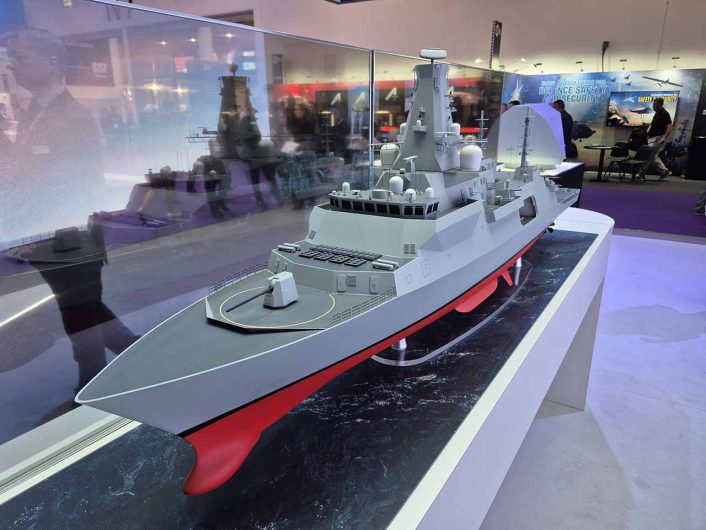
The First Sea Lord notes that “because they have no crew, the escorts are not complex vessels, they are easy to produce at scale, even easier to configure to specific mission requirements as the task demands.”
One Way Effectors
A new class of weapon which has emerged into the spotlight since DSEI 2023 are one way effectors (OWEs). This term is essentially used to describe small, expendable UAVs which can be fitted with offensive payloads, ISR, or EW equipment, much like Iran’s infamous Shahed drones.
MBDA launched their CROSSBOW OWE at DSEI 2025, aiming at the vehicle-launched market. CROSSBOW will provide a range of up to 800 kilometers, with a payload of 300 kilograms. It was designed in parallel with the previously launched OWE from this year’s Paris Air Show.
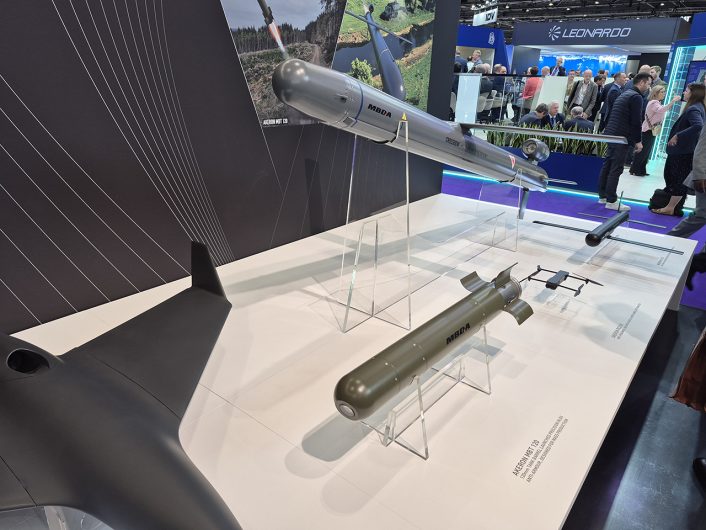
CROSSBOW could be ready for frontline service by 2026, and was developed in a remarkably short timeframe of just seven months.
MBDA also debuted a variant of their Akeron missile designed for launch from 120mm NATO standard smoothbore tank barrels. The Akeron MBT 120 includes an anti-armour warhead, low smoke rocket motor, and AI-enabled targeting. The missile boasts up to 1.5 kilometers of effective range and, using commercial off the shelf (COTS) components is able to be free of U.S. imposed ITAR restrictions.
Our reporter on the ground at the show, Jamie Gray, would also like to thank MBDA’s representatives at DSEI 2025 on a personal basis for going above and beyond to provide as much clear detail about their offerings as possible.
The need to defend against OWEs and other types of light UAVs was also apparent from displays at DSEI. An interesting electric jet powered UAV, known as Kestrel, was displayed by UK manufacturer Greenjets. Kestrel is designed to be fielded as a drone interceptor. A version of the aircraft was previously shown off at Farnborough International Airshow in 2024, but the newer, more detailed model at DSEI shows the design has matured since then.
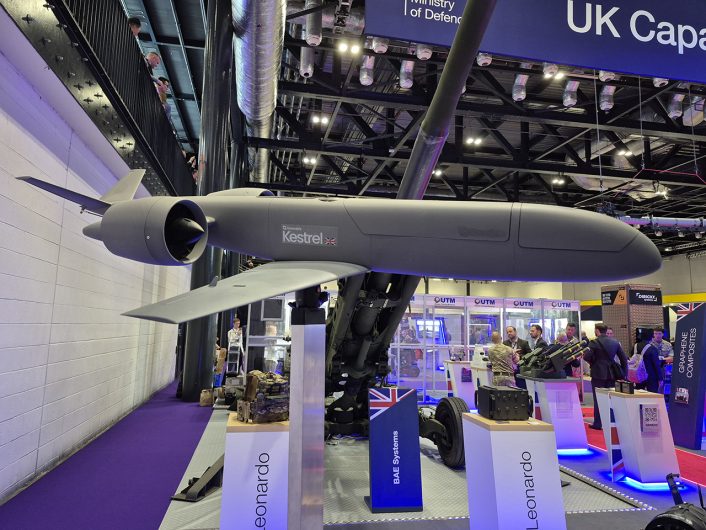
A variety of counter-drone weapons, including guns, missiles, and electronic weapons, were displayed. Many were shown fielded on board vehicles, ready for rapid deployment into modern battlefields.
The threat .. and one possible solution from Saab – the Nimbrix counter drone micro missile. #DSEI2025 #DSEI pic.twitter.com/5ubxTm65Lm
— Tim Robinson (@RAeSTimR) September 11, 2025
Moog is using #DSEI2025 to push its Reconfigurable Integrated-weapons Platform (RIwP) as a flexible solution for British Army requirements ranging from counter-drone to anti-armour missions.https://t.co/7kP1ioJTJz
— UK Defence Journal (@UKDefJournal) September 8, 2025
DSEI 2025 wraps up on Sept. 12, with more announcements likely to trickle through on the final day. There are many more stories to tell from the exhibition, and much more to elaborate on from those featured above. Keep an eye on The Aviationist for deep dives into these stories and more.

